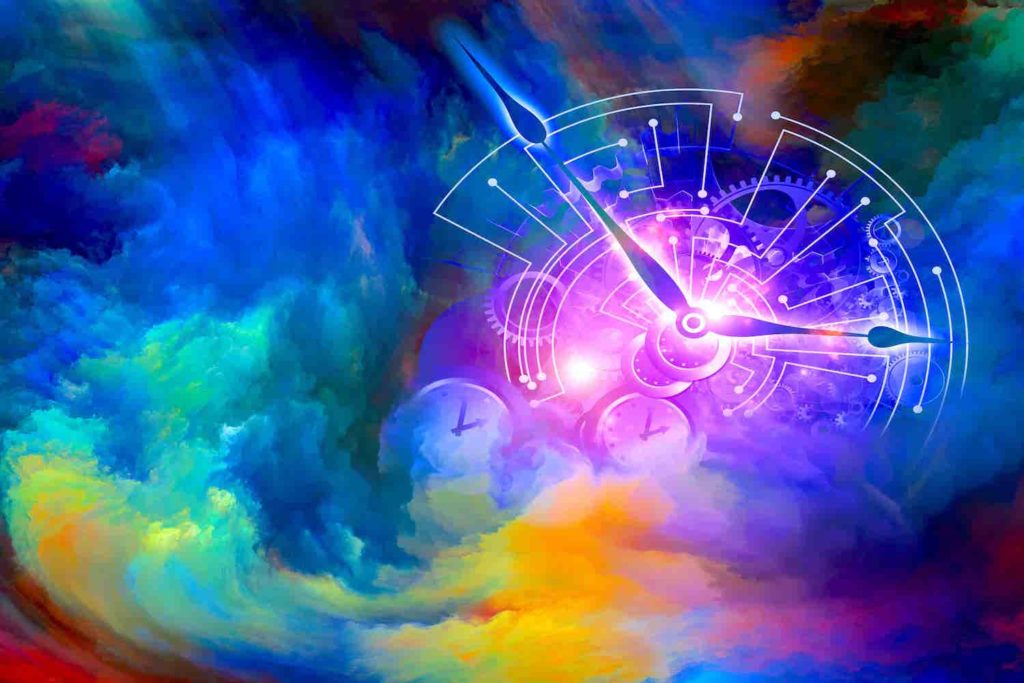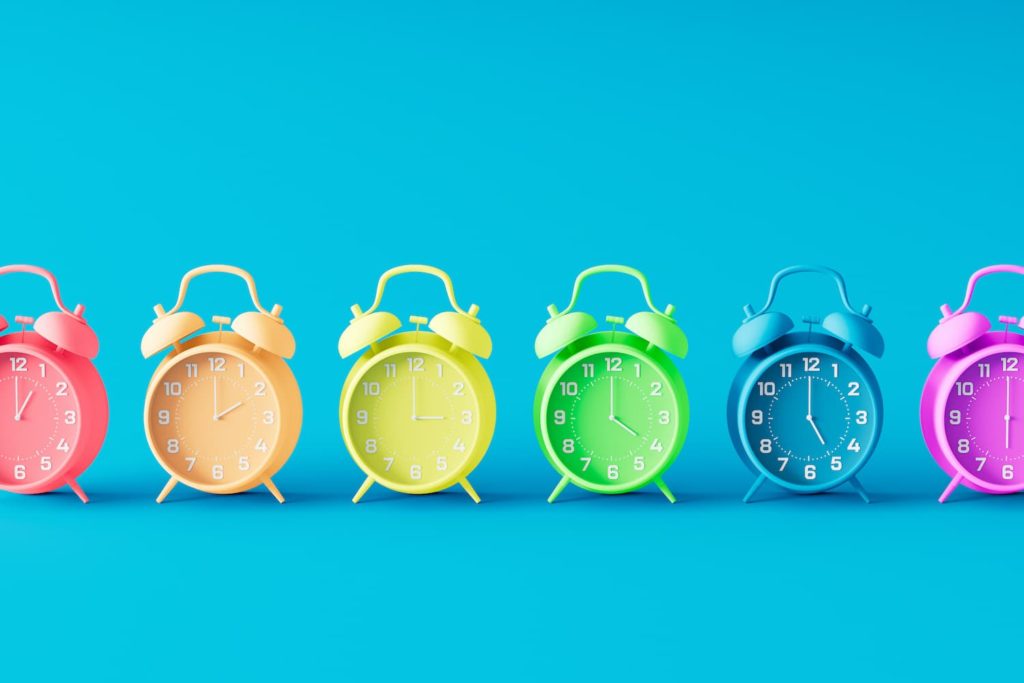
Chronology and Other Myths: Creativity with Time
The common perception of time as unchangeable allows little room for creativity. We are trapped in a world in which “time marches on.” Or are we?
Against the general view (and perhaps against logic), I contend that time is the perfect medium for creativity. Unpacking standard perceptions of time allows us to discover the exciting ways we can play and create with time.
The Shape of Time
In the modern era and in “Western” societies, the standard view of time is linear. History is made up of a series of points on an endless timeline. We think of this as fact, rather than an idea that was created or constructed. It is, however, only one possible way of looking at time.
Another possible assessment is that time is cyclical. In this view, instead of a straight line, time is a circle or an ellipsis. Many cultures around the world subscribe to this idea, and through much of history (and history is also a construct), the linear concept of time didn’t exist in any culture. The predominant and perhaps only view of time was cyclical until the last few thousand years.

When we pause to think of it, much of our shared human experience is cyclical. The seasons are a cycle: winter is not an end, but rather a prelude to spring. Birth, maturation, possible reproduction, decline, death, decay, and the fertilization of new life forms is the common life cycle for plants, humans, and other animals.
This is all to say that a chronological view is only one possibility for conceiving of time, which opens the door ever so slightly to the possibility of playing or creating with time.
Measuring Time
Our calendars, clocks, watches, and smart phones tell us that time is infinitely measurable. Seconds, days, years, and millennia stretch out infinitely in intervals that are always the same. Or are they?
Modern technology gives us the false sense of security in the measurability of time. It wasn’t that long ago that best ways of measuring time were not electronic, but rather sundials and hour glasses. The minutia of exact measurability is recent.
The standardization of calendars can also seem deceptively permanent. The predominant calendar of our present time (at least in the Euro-centric world) is the Gregorian one. For over 1600 years, however, the Julian Calendar was the principal way of measuring larger swaths of time.

Solar calendars, like the Julian and Gregorian ones, are only one way of measuring months and years. Many cultures around the world prefer the lunar calendar. In much of Asia, the lunar calendar is the predominant way of measuring lives, and the Lunar New Year is an important cultural celebration. Both Judaism and Islam rely on lunar calendars to determine their history and holidays. In Christianity, the date of Easter (a moveable feast) is determined by the cycles of the moon. When we think of the standardized Gregorian calendar as the only possible way of measuring the year and its divisions, we aren’t paying attention to the world around us, nor are we remaining open to the creative possibilities of time.
The Science of Time
One might make the argument that science is the remedy for all this uncertainty about time. The better our science becomes, the more reliable our calendars and clocks. The passage of time is permanent and measurable as long as our science is good enough.
Not so.

Albert Einstein overturned the scientific view of time as unchangeable with his general theory of relativity. From 1916 forward, the scientific community has no longer believed in the unquestionable permanence of time. As Einstein’s life and work progressed, his widely accepted scientific view of time became more radical. Not long before his death in 1955, Einstein would write in a letter, “people like us, who believe in physics, know that the distinction between past, present and future is only a stubbornly persistent illusion.”
Einstein certainly did not have the final word on time, but his work did revolutionize the long-held scientific view of the permanence of time. All this is to say that if we want to look to science for an excuse to refrain from playing with time, we will do so in vain.
Perceiving Time
Even without confirmation from Einstein, most people have experienced their own changing perceptions of time. It is a common belief that the passage of time quickens as we age. Boredom gives the impression of time dragging. The opposite is also true. How often do we hear or say, “time flies when you’re having fun”?
We inherently know that the passage of time can feel different from moment to moment and from age to age. If this is true, and if different cultures have different ideas about time, and if our ways of measuring time are unreliable, and if science tells us that time is not a constant, then what excuse do we have for not creating with time?
Playing with Time in Art
Artists and other creatives have always known that time is a possible medium for creativity. Visual art, music, and literature are just a few art forms that have constantly played with perceptions of time.
In visual art, one of the most famous examples of the portrayal of the changeability of time is Salvador Dalí’s 1931 painting “The Persistence of Memory.” In it, the surrealist painter portrays a variety of time pieces melting in the dessert. The title seems a contradiction as it emphasizes “persistence” while the imagery of the painting itself depicts time dissolving. This is just one example of the many ways that visual art questions and creates with time.

Perhaps more than any other art form, music consciously plays with time. Those who read music know that one of the first elements you see in a score is the time signature, which determines the rhythm of the section or the entire piece. The notes on the page not only communicate pitch, but also duration. Any listener of music can tell you that a song can quicken or slow the passage of time, even if they aren’t aware of the technicalities of how it is done. Composers, performers, and listeners all play with time through the musical arts.
Examples of time as a theme in literature are also abundant. From Marcel Proust’s famous seven-volume novel In Search of Lost Time (1913–1927) to the perennial best-seller A Wrinkle in Time (1962) by Madeleine L’Engle, time is a dominant theme in world literature. It is from the world of letters that we get one of the most enduring themes related to time. H.G. Wells is widely credited for bringing the theme of time travel to the masses with his novel The Time Machine in 1895.
If we want guides to create with time, we can look to the world of the fine arts. But there are examples of creativity with time that are even closer.
Time Travel in Pop Culture
Time travel as a trope may have begun at the end of the nineteenth century with H.G. Wells’ The Time Machine, but its literary importance has only grown. Isaac Asimov’s The End of Eternity (1955), Michael Crichton’s Timeline (1999), and Audrey Niffenegger’s The Time Traveler’s Wife (2003) are just a few notable examples of popular novels that invented new ways of portraying time travel.
This theme has also been important in music, television, and film. In popular music, the examples run the gamut from heavy metal to soft rock and everything in between. Black Sabbath’s “Iron Man” (1970) tells the story of a steely time traveler who witnesses and then participates in Armageddon, while Cher’s ballad If I Could Turn Back Time (1989) explores time in terms of regret.

In television, Quantum Leap (1989-1993) plays with the theme of time travel in science fiction by adding the complicating factor of random time jumps. The contemporary series Outlander (2014-present) delves into the topic at the junction of the genres of fantasy, period drama, and romance.
The filmic depictions of time travel range from biting social commentary to bubble-gum pop fun. While the time travel element of the first Planet of the Apes film (1968) isn’t apparent until the end, the discovery certainly impacts the audience. Back to the Future (1985) is one of the best-loved interpretation of the theme of the 1980s, and Bill & Ted’s Excellent Adventure (1989) is perhaps the silliest. Groundhog Day (1993) balances the comedic and the poignant in its depiction of a man stuck in a time loop. The list of portrayals of time travel on the silver screen is too long to enumerate, but each one gives a creative spin to the topic of time.
A New Beginning of Time
As we have seen, there are plenty of reasons why time is not impenetrable to creativity. There is, in fact, a long tradition of artists in a variety of genres who have played with the concept of time. But I don’t just advocate creating with time in the realm of the arts. I have consistently argued that it is just as important to exercise imagination beyond the world of art and design. But what does it mean to be creative with time in other parts of our lives?

The question leads to more questions. Time affects all aspects of our lives, so we ought to interrogate our relationship with time in each area. How can we manage time differently in our businesses and classrooms? How can we imagine time more joyfully in our friendships and love lives? Where might we overhaul our view of our time spent on hobbies or pastimes? Can we turn back time in certain areas of our lives? Do we really want to?
We can see ourselves as stuck in time or as freed by it. I know which view helps me to move forward in my pursuit of happiness and creativity. Here’s to discovering imaginative new beginnings in our relationship with time!